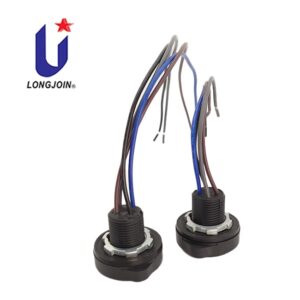The Role of Environmental Factors in the Performance of Zhaga Light Controllers
What are Zhaga Light Controllers?
The Zaga photocells are a line of photocontrol cells that are designed keeping in view the standards of quality set by the Zhaga Consortium. This ensures highest possible reliability. The Zhaga certified cells are amongst the most advanced line of photocells incorporating lates technology in luminaries. The photocontrol cells that comply to these standards can be trusted for their high performance thresholds and highest possible reliability due to the incorporation of latest smart technology.
Why Zahaga Photocells are So Reliable?

As the intelligent light control systems keeps soaring to new heights of innovation, Zhaga light controllers stand out from the rest due to their efficiency. One of the most distinguishing features of these controllers is their ability to detect and deter false triggers, thanks to the incorporation of smart technology. This ability allows them to ensure high reliability and consistent performance in the face of environmental noise.
These intelligently crafted photocell light sensors, like the Zhaga Longjoin cannot be ‘fooled’ easily by false triggers like abrupt changes in light, reflective surfaces, and other short-lived disturbances which should not be allowed to disturb the functioning of light controllers. These photocells are engineered in a way that makes them smart enough to distinguish between a genuine stimulus and a deceptive one and hence they can resist the latter to make sure the security and safety are not compromised due to an unwanted response incurred by false triggers.
Let’s see what makes them intelligent enough to resist false triggers and provide reliable performance.
How Zhaga Light Controllers Resist False Environmental Triggers?
One of the reasons why Zhaga photocells perform comparatively better in the face of disruptive environmental factors is that the manufacturers deploy a multi faceted and layered mechanism mastering the areasZhaga photocells are a of signal transmission, communication between different sensors, and the quality of physical components along with an aggressive diagnostic mechanism and ability adjust thresholds with changing environment. All these factors combined together, whether it is the quality of hardware or the intelligence of software, ensure an unmatched threshold of reliability. Let’s have a look at how these factors enable Zhaga photocells to combat false stimuli and ensure reliable performance.
• Protection Against Electromagnetic Interference
The Zhaga photocells are made by using protective components that have resistance against electromagnetic interference and they protect the sensitive components against such interferences. In high quality Zhaga photocell controllers, the PCB material used to make these sensors is highly resistant to electromagnetic fields, hence reducing their impact on sensitive components. Each and every component of Zhaga photocells whether it is a Zhaga shell, Zhaga base, or a zhaga socket are made with high quality and resistant material. This meticulously designed hardware ensures protection against malicious foreign interference with sensitive components.
• Advanced Signal Algorithms

One of the remarkable features of Zhaga cells is that they have intelligent signal processing system that can distinguish between original environmental changes and temporary false triggers. This is made possible by equipping the controllers with such smart processing techniques like self-adaptive thresholds based on sensors’ memory and frequency analysis capability. A combination of such intelligent allows Zhaga cells to make learned decisions and resist response to false triggers.
• Utilizing DALI and BLE Communications
Most Zhaga manufacturers are using some highly advanced signal communication mechanisms like Digital Addressable Lighting Interface (DALI) and Bluetooth Low Energy (BLE). These mechanisms, based on highly efficient communication protocols, ensure highly reliable communication with sensors by eliminating the risks posed by external interference. Hence they make communication and signal processing safe and secure, giving no chance to disruptive false triggers.
• Proactive Diagnostic System
Zhaga photocell control system is shielded well with the help of a strong default diagnostic mechanism. It actively monitors any issues with the functioning of control system. As an issue starts arising, the system proactively diagnoses it and before it can worsen, an action is taken. Hence, the internal malfunctioning doesn’t have a chance to act as a trigger.
• Adjustability

The ability of adjusting the threshold controls of the Zhaga cells is another reason for their success in combating false triggers. The users can adjust the thresholds according to their changing environmental factors. For example, the sensitivity levels can be adjusted along with timeout duration. This is very useful in eliminating the chances of environmental noise disrupting the normal functioning of the light controllers.
Conclusion
In conclusion, the engineering of Zhaga light controllers for false trigger resistance represents a harmonious synergy of technological innovation and user-centric design. By addressing the diverse challenges posed by environmental factors, electromagnetic interference, and user behavior, Zhaga light controllers deliver unparalleled reliability and performance in smart lighting applications. Through meticulous design, rigorous testing, and continuous refinement, Zhaga light controllers set the standard for robustness and resilience in the rapidly evolving landscape of connected lighting systems.
References
- https://www.zhagastandard.org/index.php?option=com_content&view=article&id=340:zhaga-enables-iot-upgradeable-outdoor-led-lighting-fixtures&catid=22
- https://www.nvcuk.com/technical-support/view/what-is-dali-8#:~:text=DALI%20stands%20for%20Digital%20Addressable,it%20has%20been%20substantially%20modified.
- https://www.avsystem.com/blog/linkyfi/bluetooth-low-energy-ble/#:~:text=Bluetooth%20Low%20Energy%20is%20a,particular%20implications%20for%20its%20design.





